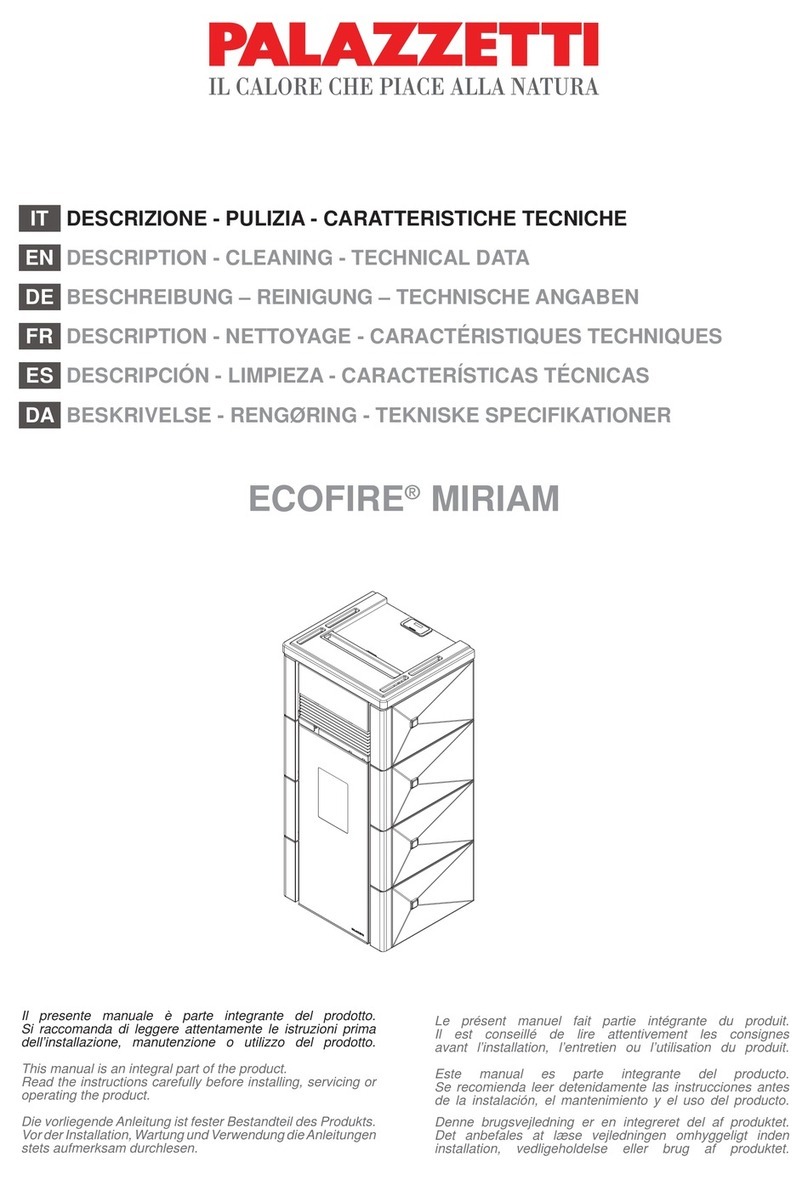
GNOME PELLET E.I. PELLET HEATER
15
hands clear of the feed mechanism when heater
is on.
3. Problem: The fire was burning well and then it
began to overfeed pellets and started backing up
into the pellet feed chute, smothering the fire.
Solution: When the pellets are overfeeding, it
usually means that the air flow has been
reduced. Check the fire pot air intake holes to be
sure they are clear. Check to see if fire pot was
properly seated in the pot tray. If you use a low-
grade pellet and clinkers (fused ash and dirt)
form in the bottom of the fire pot and chock the
air intake, you might consider changing the
brand of pellets to one that burns cleaner. You
must let the fire go out before removing and
cleaning the fire pot. Never vacuum out the
heater when the heater is in operation! The hot
ashes can lodge in your vacuum cleaner and
cause a fire! You must clean the heat exchanger
manifold (see Figure 13) regularly to ensure a
good air to fuel ration, thus allowing the heater
to "breathe" properly. You must also check the
tee and vent pipe to see that they are not clogged
and full of ash.
4. Problem: The heater was burning well and then
soot began forming on the door glass.
Solution: Black soot forming on the door glass
means that the combustion is not right and the
heater needs a good clean out. Some brands of
pellets burn much richer than others and you
might have to change brands of pellets and/or
have the air/fuel settings readjusted by your
dealer. It is normal to have the glass cloud up
after several hours of burning, but it should
wipe off with a good window cleaner. If the
glass turns black quickly, then the heater needs
a good clean out.
5. Problem: We had a power failure and the heater
emitted smoke for about five minutes.
Solution: If the heater emits smoke during a
power failure and you have frequent power
failures, then we suggest you purchase the
battery back-up system. If the vent pipe is
installed according to these instructions, the
smoke will siphon out of the pipe in most
instances.
6. Problem: After several weeks of outstanding
performance, the heater suddenly stopped and
the red light under the control panel came on.
This light is the High Temp/Flue indicator light.
Solution: The High Temp/Flue indicator light
indicates that fly ash has built up in the exhaust
system and/or there is a restriction in the
exhaust/flue system. Check the pipe system for
excessive ash and clogging, particularly the vent
cap. Remove the clean out cap on the tee and
make sure that ash has not blocked the exhaust
air flow. This automatic shut down in case of
flue clogging is a safety feature, and if the shut
down occurs it means you have a problem and
should consult a service technician and/or clean
your pipe and heater thoroughly. If you feel the
fly ash build-up is excessive, we suggest you try
another pellet brand. In most climates the pellets
and fly ash can absorb moisture from the air and
create creosote and a severe clogging problem.
Keep this in mind when you store and handle
your pellets. The heater warranty does not cover
the quality of the fuels used or the way they may
be handled, either before or after you've
purchased them.
7. Problem: I turned off the switch and the heater
continued running.
Solution: This is normal. The exhaust blower
will keep running until it cools down and then it
will automatically turn off. This can vary by the
temperature the exhaust has reached and the
temperature of the cooling air.
8. Problem: Fan motor speed varies, sometimes
running low and sometimes surging. Will run on
"High" or "Clean" but not on "Low."






















